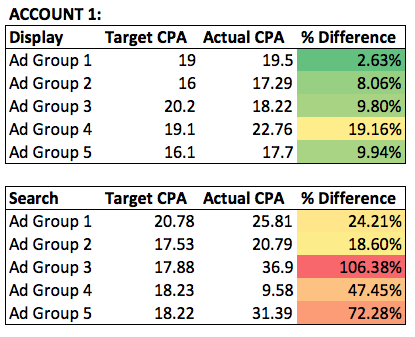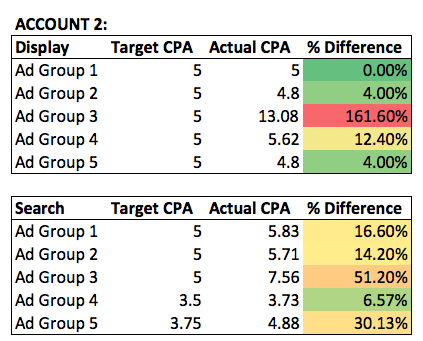September 15, 2017
Using CPA bidding is like living with an unpredictable pet. He’s as likely to bite your guest’s hand as he is to be a saint. There are mixed feelings about using Target CPA bidding. But there’s one big question: are there enough benefits to CPA bidding to rationalize forfeiting the control that manual bid changes give us?
If I increase my target CPA, will I get more conversions?
Yes. If increasing cost-per-conversion is not a concern, go ahead and increase CPA targets and receive more conversions. In the first chart, targets were increased in high converting ad groups and conversions rose accordingly. Actual cost-per-conversion increased 27% after 30 days and conversions increased by 67%. Because conversion volume is the goal, the 67% increase in conversions outweighs the 27% increase in cost-per-conversion.

The second chart looks at ad groups with zero conversions within the past 30 days. When CPA Targets were increased, the ad groups were revived and began to see conversions with the more aggressive CPA target. Higher CPA targets can quickly increase conversion volume.

But wait! Before you commit to CPA bidding, let’s remember that target CPAs are simply guidelines for bid aggression. Actual costs-per-conversion rarely line up directly with target CPAs. When we increase targets, we are telling Google to be more aggressive with our bids. This will cause conversion rates to drop and cost-per-conversion to increase. In the example below, the ad group saw a 2% increase in CPA Target and a 51% increase in actual cost-per-conversion.

How long should I run CPA Bidding before I judge performance?
For me, 30 days is the appropriate amount of time to start drawing conclusions about the success (or failure) of CPA bidding. Depending on the volume of conversions in the campaign, it might take longer for a lower converting campaign to start performing close to goal. I have come to expect that when first starting CPA bidding cost-per-conversions will fluctuate for the first couple days after I’ve changed the bid strategy.
If I make a change, could it all go wrong?
Yes and no. Speaking anecdotally, I have added ad groups, restructured a campaign and implemented day parting to CPA Bidding campaigns and seen no lull in performance. However, I have implemented a new ad copy test in this one campaign and performance slowed for weeks as the campaign readjusted. While many factors can affect performance, I expect a few days of slower performance after changes to my ads in CPA bidding campaigns.

The graph above demonstrates one of those switches. The unpredictability of how a CPA bidding campaign may react to changes is a downside to this bidding type.
What happens if I set Targeted CPAs well below the suggested target?
To me, this depends on the definition of ‘well below’ and the realistic expectations for the account. When changing the bidding type of a campaign, Google AdWords will provide a suggested CPA target based on recent performance. In the example below, the orange line demonstrates the drop in cost-per-conversion when CPA bidding was set to $30 dollars below the recommended target. While it did not drop cost-per-conversion quite as low as the target CPA, it did fall significantly after the switch.

Realistic expectations are important. We must ask ourselves, “Can the account actually reach the desired target?” In this campaign below, historical data had demonstrated that the campaign could sustain lower cost-per-conversion, but had recently seen cost-per-conversion rise month-over-month. When the campaign switched to CPA bidding, targets were set similar to the cost-per-conversion from several months previous. Again, the campaign did not immediately begin performing at the target goal, but cost-per-conversion dropped 7% week-over-week.

However, before slashing CPA targets, its important to remember that conversion volume will fall along with the cost-per-conversion. Depending on goals, conversion volume with a higher cost-per-conversion is the appropriate choice.
Do you prefer Search or Display?
Display. To me, Display is more predictable than search when using CPA bidding. On average, the actual cost-per-conversion for a display campaign will be closer to the set CPA target. In the account below, I choose the top converting ad groups from a search and display campaign. The majority of the display ad groups’ actual cost-per-conversions are within 10% of the target CPA. The search campaign from the same account sees a much larger variety in its results. The actual cost-per-conversion ranges anywhere from 18% to 106% from the target CPA.

For good measure, I decided to look at another account that uses CPA bidding. Looking at the top five converting ad groups of a search and display campaign again, Display’s actual cost-per-conversion were on average closer to the Target CPA. Besides ‘Ad Group 3’ in the chart below, the actual cost-per-conversions of the Display campaign have a smaller percent difference.

Conclusion
Though when CPA bidding decides to be crazy, my decision is challenged, I side with Google and Team CPA Bidding. However, I wouldn’t use it in every campaign. When there is high conversion volume and a hard cost-per-conversion goal, I believe this would be a perfect opportunity to try CPA Bidding.